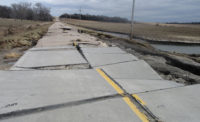Richard Spinrad, administrator of the National Oceanic and Atmospheric Administration, hopes building owners, insurers, local officials and other federal agency heads use the agency's Climate Mapping for Resilience and Adaptation website at resilience.climate.gov to make decisions about climate related to building and infrastructure projects.
Available since September, CMRA links hundreds of Esri basemaps with agency and other federal government data about climate risks across the U.S. such as heat hazards, sea level rise predictions and tools for site and community assessments through which users can run their own plans, said Spinrad in an in-depth presentation at the Esri User Conference in San Diego July 11.
“Ultimately, it’s our job to boil the information down to decision support,” Spinrad said at the press conference. “We’re really in the business of solution support.”
The entire federal government is being encouraged to use CMRA for construction decisions, Spinrad said. The site was developed by GIS technology giant Esri under a contract with NOAA using funds from the 2021 Infrastructure Investment and Jobs Act. Data for the site comes from sources including the National Weather Service, NOAA climate models, the drought.gov website and the Federal Emergency Management Agency.
Information on past, present, and projected future climate conditions will be regularly updated with the latest data, Spinrad said. NOAA is also working to make CMRA information available in a format that is focused on the insurance and reinsurance industries.
Spinrad said NOAA would strive to keep the data behind CMRA as up-to-date as possible even with changing scientific predictions. Both NOAA and the U.S. Commerce Dept., of which it is part, are big believers in open data, he said, noting that NOAA would continue to maintain the data to insure it is rigorous enough to keep CMRA relevant.
“We know things change, it’s a moving projection, you’re going to see a lot of increased capabilities in the social sciences piece,” he said. “If we’re doing this right, [users] are not necessarily using the data, they’re using the information and intelligence that comes from the data.”
Also sharing details of a similar web portal the U.K. government has made available was Richard Bevan, chief technology officer of the U.K. Met Office.The U.K. Met Office's web portal went online in late June, and Bevan said the agency is already seeing engagement with U.K. decision makers.
“It brings together standard predictions with impact predictions,” he said. “The way we help people make those decisions is good data and updating it.”
Esri President and Founder Jack Dangermond said there are 350,000 Esri customers that make decisions related to development of one type or another in government, insurance and construction ownership and need accurate climate data. He compared the ease of using CMRA to the Johns Hopkins COVID-19 map portal, which was also an Esri ArcGIS basemap.
“The scale of granularity most needed is there, it goes down to the census tract level,” he said. “People are using CMRA in these communities, it’s going to be really relevant.”






Post a comment to this article
Report Abusive Comment